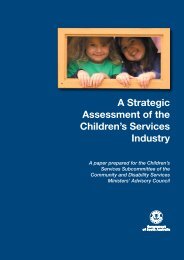Global Study On Child Poverty And Disparities (PDF) - Social Policy ...
Global Study On Child Poverty And Disparities (PDF) - Social Policy ...
Global Study On Child Poverty And Disparities (PDF) - Social Policy ...
Create successful ePaper yourself
Turn your PDF publications into a flip-book with our unique Google optimized e-Paper software.
The answer varies depending on which poverty<br />
measure is used and whether it is adjusted for<br />
local price differences. The challenges that lowincome<br />
households face can vary from province<br />
to province – from the high cost of housing in<br />
Port Vila to distance from services and markets in<br />
more remote provinces like Torba and Tafea.<br />
Other factors that appear to have an important<br />
bearing on whether children live in poverty include<br />
household size (with larger households more<br />
likely to experience poverty) and education (the<br />
more educated the head of a household, the<br />
less likely it is to be poor). Gender did not seem<br />
to play a significant role – at least in this study,<br />
which focused on the experience of households<br />
rather than individual children, in a country where<br />
woman-headed households are relatively rare.<br />
In additional to choosing the most appropriate<br />
international, national, or regional poverty<br />
measure, it is also necessary to choose an<br />
equivalence scale that adjusts the measure for<br />
specific household attributes such as number<br />
of members and ratio of adults to children. How<br />
much do larger households benefit from an<br />
economy of scale? How much less does it cost<br />
to meet a child’s basic needs than to meet an<br />
adult’s? Further study is needed to determine<br />
which of the wide range of existing equivalence<br />
scales is appropriate for Vanuatu and other Pacific<br />
Island countries.<br />
Pillars of well-being<br />
While the conventional approach to assessing<br />
child poverty is important, its close focus on<br />
expenditure (even when broadened to include<br />
non-cash household production) gives an<br />
incomplete picture. Certain needs are universal;<br />
the goods and services that meet those needs<br />
can be considered pillars of well-being, and<br />
the inability to meet them can be considered<br />
deprivation. In pursuing this second approach to<br />
assessing disparities in child well-being, this study<br />
relied on data from the 2007 Multiple Indicator<br />
Cluster Survey:<br />
• Shelter (primarily measured by the quality of a<br />
dwelling’s floor and roof)<br />
• Sanitation (type of toilet facility)<br />
• Safe drinking water (type of water source)<br />
• Information (access to radio, television and<br />
telephone)<br />
• Food (existence of stunting, wasting or<br />
underweight)<br />
• Education (current and past school attendance)<br />
• Health (immunization status)<br />
Deprivation was subdivided into two categories:<br />
‘severe’ and ‘less severe’. Some types of<br />
deprivation depend on a child’s age – for<br />
example, everyone needs safe drinking water, but<br />
infants do not suffer directly from lack of access<br />
to information or education – and thus were<br />
measured for the relevant age group rather than<br />
for children as a whole.<br />
Of these categories, information deprivation<br />
was most prevalent among Vanuatu children<br />
at the time of the study, but this appears to be<br />
changing since the telecommunications reforms<br />
of 2007. Health, shelter, and food were other most<br />
frequently occurring severe deprivations. Patterns<br />
of deprivation vary a great deal from one location<br />
to the next within Vanuatu:<br />
• Rural children are more likely to experience at<br />
least one severe deprivation.<br />
• The highest percentage of children experiencing<br />
severe deprivation is in Torba Province, and<br />
the lowest in Port Vila.<br />
• Deprivation is highest in Torba for shelter,<br />
in Sanma for sanitation and in Tafea for water<br />
deprivation.<br />
• Urban areas tend to have the highest rates<br />
of food deprivation and the lowest rates of<br />
education and information deprivation.<br />
• Younger children experience higher rates of<br />
severe deprivation than older children.<br />
In Vanuatu, both deprivation and poverty have a<br />
strong regional dimension. More remote areas<br />
tend to experience the worst shelter, education,<br />
and water deprivation, and to face challenges<br />
related to transportation and communication.<br />
Port Vila experiences the worst food and health<br />
deprivation, and must deal with a higher cost of<br />
living and greater reliance on cash incomes and<br />
the formal labour market. Effectively meeting the<br />
different needs of children in remote and urban<br />
areas remains a major challenge.<br />
Promoting child well-being<br />
Promoting child well-being in Vanuatu requires<br />
an evidence-based approach. More survey data<br />
14
















